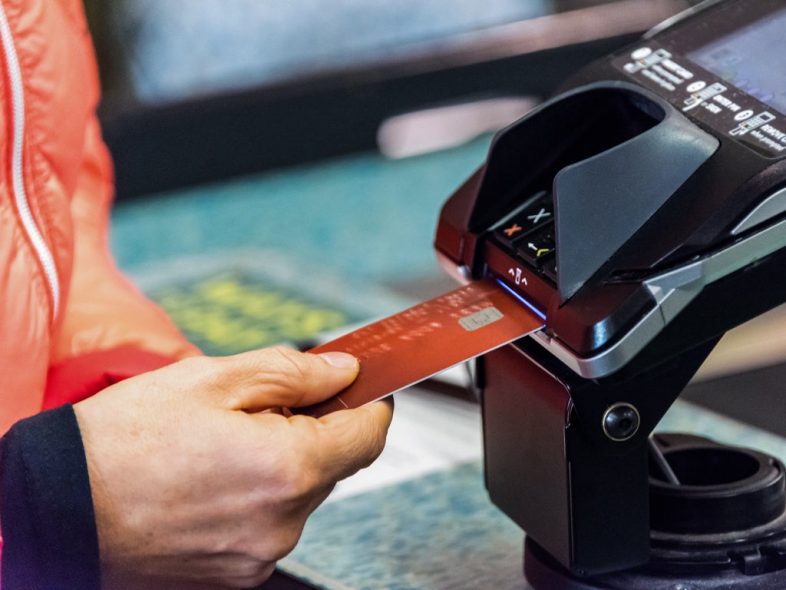Frequent travelers were the first to accept cards with embedded EMV microchips, mainly because they made it much easier to use US credit cards abroad. However, there are still some key differences between chip technology credit cards offered at home and cards offered by card issuers outside the United States.
For example, cardholders in most other countries dial a PIN (personal identification number) to verify their identity with their chip and PIN cards, while most US issuers require a signature instead. As a result, most credit cards with a chip in the United States are effectively considered chip and signature cards.
It’s not a big difference, but it’s still worth mentioning since most Americans have never had a PIN associated with their credit card. And while most major card networks are in the process of opting out of signing, that doesn’t mean you’ll automatically be prompted to enter a PIN instead.
However, even if true chip and PIN cards are not standard in the United States, there are still a few reasons why it would be a good idea to have such a card. Read on to find out how chip and PIN credit cards work, why they’re considered more secure, and which cards offer this feature if you’re looking for a credit card with updated security features.
What is a chip and PIN card?
A true chip-and-PIN credit card is a type of credit card that requires the user to enter a selected PIN to complete a transaction. Chip and PIN credit cards also have a square-shaped microchip that generates and stores information as transactions are made throughout the month. This distinguishes them from older credit cards that used a magnetic strip containing information about the cardholder.
As mentioned, most cards with this technology in the US are actually chip-and-sign cards that offer similar security features without the need for a PIN.
In any case, chip credit cards continue to grow in popularity in the United States. According to 2021 EMVCo data, from July 2020 to June 2021, 77.52% of U.S. credit card transactions were made using credit cards with EMV chip technology. This figure has grown from 67.84% in the previous period (July 2019). to June 2020).
How do Chip and PIN cards work?
Instead of swiping a credit card through a payment terminal, chip-and-PIN credit cards (and chip-and-sign cards) require you to “dip” your card into the end of the payment terminal instead. As soon as you insert your card into the terminal, transaction information is generated and stored in a square microchip on your credit card.
Some credit cards with embedded data microchips require a four-digit PIN as a way to verify card ownership and complete a transaction. You may be assigned a PIN, or you may choose your own. In either case, asking the customer to enter a code adds an extra layer of security, as it makes it harder for a thief to steal a physical card and use it in a store.
But a card can have more than one “Cardholder Verification Mode” (CVM), so some issuers add PIN capability as an additional mode.
Cards that prefer a signature but use a PIN as an additional mode may still require a signature on the receipt. But you will be asked to enter your PIN if you are at a terminal that cannot accept a signature, possibly abroad.
However, only a few cards in the US, mostly issued by credit unions, have true PIN priority, which means consumers are asked to enter their PIN first in every transaction if the merchant supports this option.
The most versatile cards also have a so-called “offline PIN”. These cards actually store the PIN securely on the chip itself, so cardholder verification can even take place in a separate offline kiosk. The technology was developed in other parts of the world where the telecommunications infrastructure was not as reliable as in the US.
If your card has a network PIN, the terminal must electronically communicate with the issuer over the network to ensure that your PIN is correct each time you enter it.
Are Chip and PIN Credit Cards Safe?
Yes. With a chip and signature card, your name can be forged. Also, PINless cards are easier to use for cardless transactions, such as online shopping.
Generally speaking, EMV chip cards are more secure than magnetic stripe cards due to the way transactions are processed. EMV Chip Cards use a unique authentication code for each purchase made and this code cannot be used more than once. Not only that, EMV chips are almost impossible to copy or duplicate.
In any case, it’s important to note that credit cards have many security features, whether they have a magnetic stripe, a chip and PIN, or a chip and signature. Most credit cards offer $0 fraud liability, so you are not responsible for any payments made from your card or card number without your consent. In the meantime, the Federal Trade Commission (FTC) reports that your legal liability for credit card fraud is limited to $50 no matter what.
The best credit cards with chip and PIN protection
While most U.S. credit cards require a signature rather than a PIN, many offer the security and protection of EMV chip technology. Consider the following options for your next credit card.
Bank of America Unlimited Cash Rewards credit card
The Bank of America® Unlimited Cash Rewards Credit Card comes with no annual fee, and cardholders receive a flat rate of 1.5% cash per dollar spent. Bank of America cards can also be set up with a PIN if you prefer.
New cardholders can earn $200 in online bonuses by spending $1,000 on purchases within 90 days of opening an account. Bank of America Preferred Rewards customers can also earn between 25% and 75% more cashback for every dollar deducted from their card.
Bank of America Travel Rewards credit card
Bank of America will also allow you to set up a PIN on your Bank of America® Travel Rewards credit card. This card also comes with no annual fee, and new customers can earn 25,000 Online Bonus Points by spending $1,000 on purchases within the first 90 days of opening an account. All purchases earn rewards at the rate of 1.5 points per dollar spent. This card also includes the APR Starter Offer, which allows users to earn 0% APR on purchases for 15 billing cycles, followed by variable APR from 14.24% to 24.24%.
PenFed credit union credit cards
A random PIN is assigned and mailed separately for PenFed Credit Union cards, or you can call customer service to set up your PIN. Various cards are available with different types of rewards and no foreign transaction fees. PenFed says on their website that you can call to set a PIN (or change your PIN) on their credit cards, debit cards, and ATM cards.
First Tech Credit Union cards
Even if you do not qualify for First Tech membership, you can still join by calling the credit union or visiting one of its branches. His Odyssey Rewards World Elite Mastercard has no foreign transaction fees and rewards based on how much you travel. It also has a $75 annual fee that is waived in the first year.
Andrews Federal Credit Union Visa Platinum Rewards Card
To be eligible, become a member of the American Consumer Council ($8 annual membership or $15 one-time lifetime fee) and deposit at least $5. Then, according to the spokesperson, specifically request a real card with PIN priority; otherwise, you get a preferred signature card with a PIN as an additional verification mode. The Andrews Platinum Rewards Card is free of annual fees and foreign transaction fees.
State Department credit union cards
To be eligible, you or a family member must work for the US Department of State or one of its affiliates, or you can join the American Consumer Council (annual membership of $8 or a one-time lifetime fee of $15) .
If you answer yes when the app asks if you live abroad or travel frequently, you will receive a credit card with PIN priority. If you answer no, the signature will be used by default. If you already have a card, call customer service to request PIN priority. The cards have no fees for foreign transactions.
bottom line
Whether you get a real credit card with a chip and PIN or a card with a chip and signature, EMV chip technology can make your transactions more secure and convenient. If you travel internationally often, you may even find that having a chip technology card allows you to use your card at more retailers in general.
With that in mind, it’s wise to look for credit cards that offer chip technology, including the best-rewarding credit cards on the market today. By comparing cards with EMV technology based on features and rewards, you can get something in return for your spending and feel more secure when shopping.
Editorial disclaimer
The editorial content on this page is based solely on the objective judgment of our contributors and is not based on advertising. It was not provided or ordered by credit card issuers. However, we may receive compensation when you click on links to our partners’ products.


